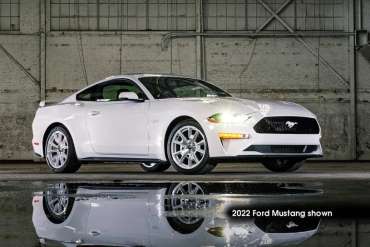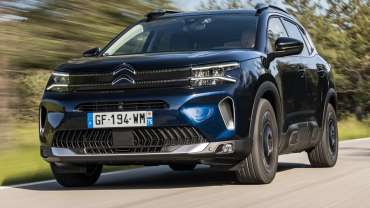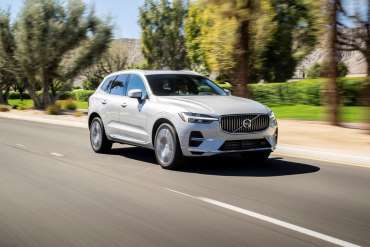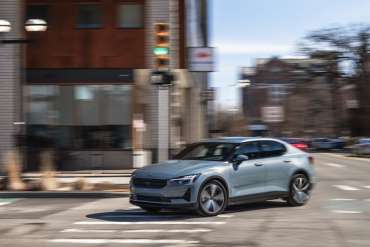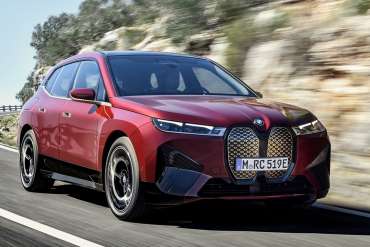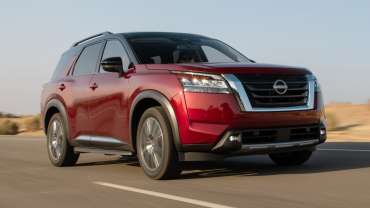
Worldcarblog.com
Citroen C5 Aircross SUV (2022) review: soft serve
Bauer Automotive's new cars editor, although just as happy behind the wheel of a classic
► Petrol, PHEV and even diesel power
► More assertive nose after 2022 facelift
► Comfort focus unchanged
In the white heat of the family-friendly SUV market you can’t rest on your laurels for a second. So, after four years and nearly 250,000 European sales, the Citroen C5 Aircross has gone under the surgeon’s knife to bring it into line with the brand’s latest design themes.
For those playing spot the facelift that means a new ‘more assertive’ front bumper and headlight combo, some new ‘3D’ rear lights and a new design of 18in wheels. Inside you’ll find a larger and higher definition 10-inch infotainment system slotted into a redesigned centre console.
In other words, it’s a fairly minor update. Is it enough to compete against the Nissan Qashqai, Kia Sportage and Skoda Karoq to name but three? There’s only one way to find out…
2022 Citroen C5 Aircross: What about the oily bits?
You won’t find any surprises here, with the same three engines powering the front wheels and no changes to the suspension, either. In other words, the C5 Aircross still puts passenger comfort over any notion of sportiness or handling prowess. So far so very Citroen, and all the better for it.
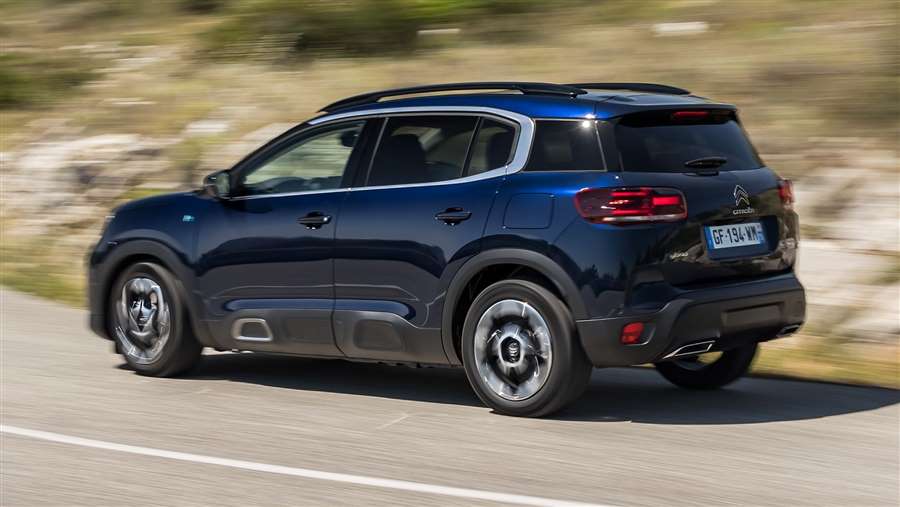
Your cheapest engine choice is the familiar 1.2-litre Puretech turbo triple available with either a six-speed manual or eight-speed automatic gearbox. Its 127bhp and 170Ib ft of torque sound meagre on paper, but a mid-10sec 0-62mph time is respectable enough and real-world performance is adequate in all but extreme situations.
A similarly brisk albeit far torquier 1.5-litre diesel is available, although it’s the plug-in hybrid that predictably promises the cheapest running costs. Its 222bhp power output is the highest of the range and, like the pure petrol and diesel, it drives the front wheels alone.
There’s the option of PSA’s familiar Grip Control system on all but the PHEV. This is a switchable traction control system, which offers Mud, Snow and Sand modes to help you out of sticky situations and hill descent control.
2022 Citroen C5 Aircross: And the driving experience?
Our off-road excursion, which involved some steep inclines and loose surfaces, revealed that they do make a difference, although the mud and snow tyres that are bundled in no doubt helped. There are also two driving modes for general on-road use, Eco and Sport, both of which feel like they’re trying to make the car do something it would prefer not to do.
Better to just leave it in its regular setting most of the time, and not even bother with the paddleshifters; the automatic slurs most changes pleasingly, and rarely leaves you feeling like you’re in the wrong gear. It is a bit hesitant to kick down or accelerate hard from a standstill, though and you’ll feel the occasional sharper shift.
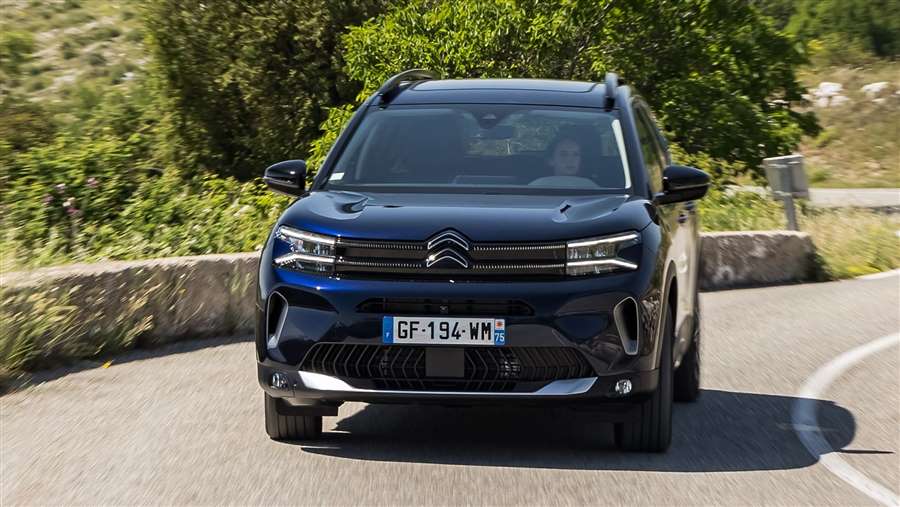
On the subject of refinement, the PHEV can be a little boomy when pushed and never fully fades into the background at a cruise. Even so, it’s a smoother option than the buzzier Puretech three-pot. Wind and road noise are well contained, especially in the PHEV which gets laminated front side windows, making this a great cruiser.
How the car rides plays perfectly into this relaxed feel. The C5 Aircross comes as standard with Citroën’s Advanced Comfort Suspension system, which uses two bump stops per suspension unit, one at the top and one at the bottom. This allows the C5 Aircross to run a softer spring, boosting comfort.
On rough surfaces that use all of the spring’s travel, the bump stop helps absorb the shock and smooth out any vibrations rather than simply stopping the suspension components clattering into each other. You certainly appreciate the gentle way it devours speed bumps, although you do still feel a little fidget on patchy surfaces, especially in the Puretech. Still, you can’t expect too much from a non-adjustable suspension system fitted to a sub-£30k family SUV, can you?
It’s certainly not set up as a B-road blaster, although there’s less bodyroll than you might expect. Even so, twisty Tarmac reveals a front end that’s keen to give up first, overprotective ESC and a sense that while you can carry reasonable speed, the C5 just wishes you’d chill out and stop driving like a bloody teenager.
2022 Citroen C5 Aircross: What’s so special about the cabin?
Unlike the fussy DS 7, or indeed Peugeot’s slightly over-ornamented 3008/5008, the C5 Aircross is rather subtle and grown-up inside without being dour like a Grandland. There aren’t too many flourishes or flamboyant angles and just enough squishy plastics to give a feeling of plushness.
Up front, all versions get Citroën’s Advanced Comfort seats, which are supremely well shaped and cushioned thanks in part to even more memory foam to sink into. They are more armchair than racing bucket, with the flat bases and backs doing little to hold you in place. In the back, there are three equally sized seats, all adult size (although not as big as those up front), and they can be moved forward and back or folded and reclined individually.
This not only allows the rear passengers to sort out the most conversation-friendly configuration, it also maximises your luggage-carrying possibilities. With the rear seats in use you get at least 580 litres, and up to 720. With them folded flat you get 1630 litres, dropping to 460/600/1510 litres in the plug-in hybrid.
A sliding panoramic roof comes with top spec or is a £990 option. It adds to the brightness of the interior but it eats into the rear headroom, making the difference between six-footers being comfortable and slightly hunched.
As for the new infotainment system, it’s sharper looking and more responsive than its predecessor, although having the temperature displayed either side of the touchscreen does effectively reduce its size down from 10-inches to nearer eight. Annoyingly pressing on the readout simply takes you to the climate menu rather than letting you change temperature, making them a pretty pointless addition.
Citroën C5 Aircross: verdict
There’s no doubt the C5 Aircross nails its brief, proving to be one of the most comfortable SUVs in its class while providing a generous boot and decent if not outstanding rear seat space. It’s certainly not sporty, yet there’s a certain pleasure in driving it smoothly and relaxing into the experience.
Although it’s pricier and comes with a smaller boot, the PHEV is the version we’d have. The improved refinement, especially in electric mode, better ride and promise of mega MPG if you regularly charge make it worth the additional initial outlay in our book.
Source: carmagazin.co.uk
The permitted speed of self-driving cars will be increased to 130 km/h
The United Nations Economic Commission for Europe (UNECE) has agreed to increase the maximum speed for self-driving cars in certain situations up to 130 kilometers per hour.
According to a UNECE decision, the speed limit for self-driving vehicles would be raised from 60 to 130 kilometers per hour.
UNECE spokesman Jean Rodriguez said at a press conference on Friday that the recommendation should be formally adopted by the World Forum for Harmonization of Vehicle Regulations in late June.
If adopted, it will take effect in January 2023, Rodriguez said.
The UNECE World Forum on Vehicle Harmonization is an intergovernmental platform responsible for regulatory frameworks concerning the safety and environmental performance of vehicles, their subsystems and parts.
Self-driving or autonomous vehicles are based on advanced sensors, which collect information about the environment, deep multilayer neural networks and deep learning, which are used to identify roads, vehicles, objects and people, from data collected from sensors.
2022 Volvo XC60 Recharge T8 Extended Range Gets More Everything
Added batteries, a tweaked turbo four, and a more potent electric motor deliver more power while doubling all-electric capability and lowering emissions.
One of the distinct advantages of the auto industry's current moment of record profitability is the ability it gives carmakers to invest in truly worthwhile upgrades during mid-cycle refreshes. Witness Volvo's plug-in hybrids, specifically the latest version of the XC60 Recharge T8 Extended Range. Like its XC90 big brother and the company's refreshed S60, V60, and S90 hybrids, it sports a new-for-'22 powertrain that extracts more power from its electric motor, revised to loft its lusty (and also freshly tweaked) supercharged and turbocharged 2.0-liter four-cylinder to new heights, with additional battery cells delivering greater all-electric range.
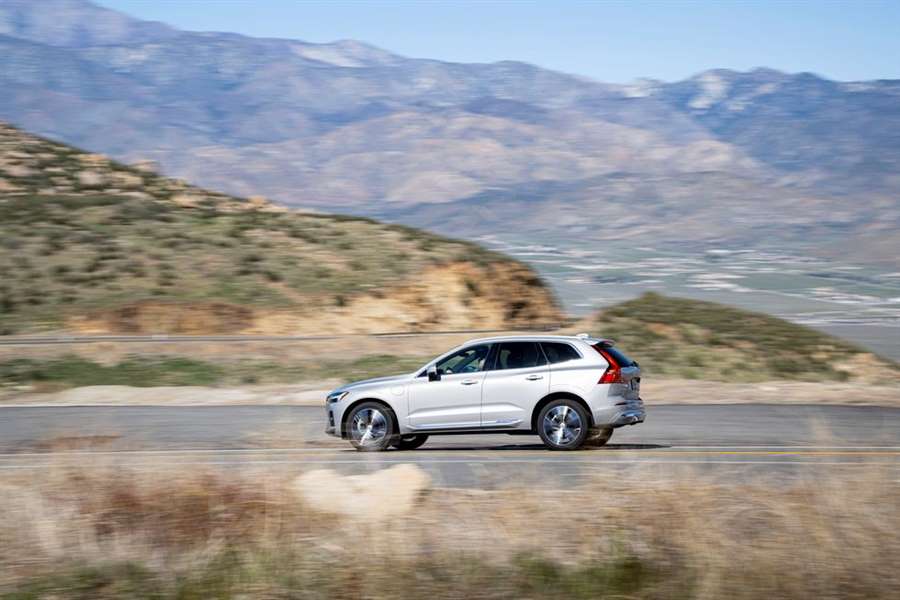
Thanks to a new, third layer of cells, the T8 battery pack's capacity jumps from 9.1 kWh to 14.9, increasing its range in all-electric operation—what Volvo calls "Pure" mode—to 36 miles, up from 19, a not insignificant improvement. Volvo research suggests that customers spend fully half their time in all-electric mode. For those with charging capability at home or at work, Volvo proposes, most daily driving can be tackled in the new model on electric power alone. As a further benefit, buyers qualify for the federal government's full $7500 tax credit, as against the $5419 available for buyers of its predecessors with their skimpier range.
Revisions to the powertrain see its output skyrocket 55 horsepower to a whopping 455 total horsepower, with the upgraded electric motor chipping in 143 of those to go along with the 313 ponies that come courtesy of the tweaked gasoline mill. Up substantially from the outgoing model's 87 horsepower, electric motive force gets directed to the rear wheels, while the gas engine takes care of the fronts. With this much horsepower and a Brobdingnagian 523 pound-feet of torque, the refreshed mid-size SUV stands with its aforementioned brethren as the most powerful cars Volvo has ever brought to market. Such is the promise and pleasure of electrification.
With an EPA-estimated 63 MPGe, the economy potential is infeasibly high. In a random sampling of roads at a launch event in and around Palm Springs, California, helpless to resist the siren call of its massive power, we still managed to eke out a still creditable indicated average of 45 MPGe.
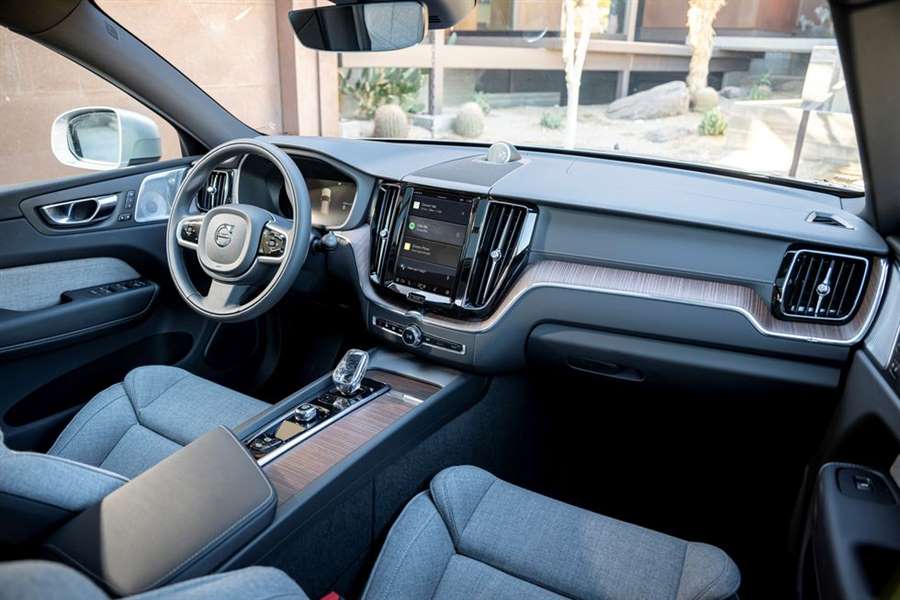
Volvo cites a 4.5-second 60-mph sprint for the Recharge T8 Extended Range (shaving half a second off the old model's best effort), and performance with both powerplants firing is predictably sparkling. As well it ought to be with that much torque to call on, even allowing for the XC60 hybrid's borderline portly claimed 4758-pound curb weight. But despite the extra juice, the power glut is not obtrusive as the vehicle's two diverse and generally harmonious powertrains got down to it, save a one-time, mild clunk from the rear. In Pure electric mode, pickup remained acceptably brisk but not neck-snapping.
One-pedal driving—where regenerative braking causes the car to slow when the driver lifts off the accelerator without applying the brakes—is a new and much appreciated feature for the hybrid model, one that was previously seen only on the firm's EV offerings. Those who've not experienced it will quickly get the hang of one-pedal operation and, in our experience, quickly grow to enjoy it, slowing down with a counterintuitive smoothness that quickly becomes second nature. Use of the feature is selected by double-clicking the gearshift into Drive after selecting the Pure driving mode on the central screen. It proved unexpectedly addictive while charging up this sure-footed chassis, then rapidly descending, winding mountain roads.
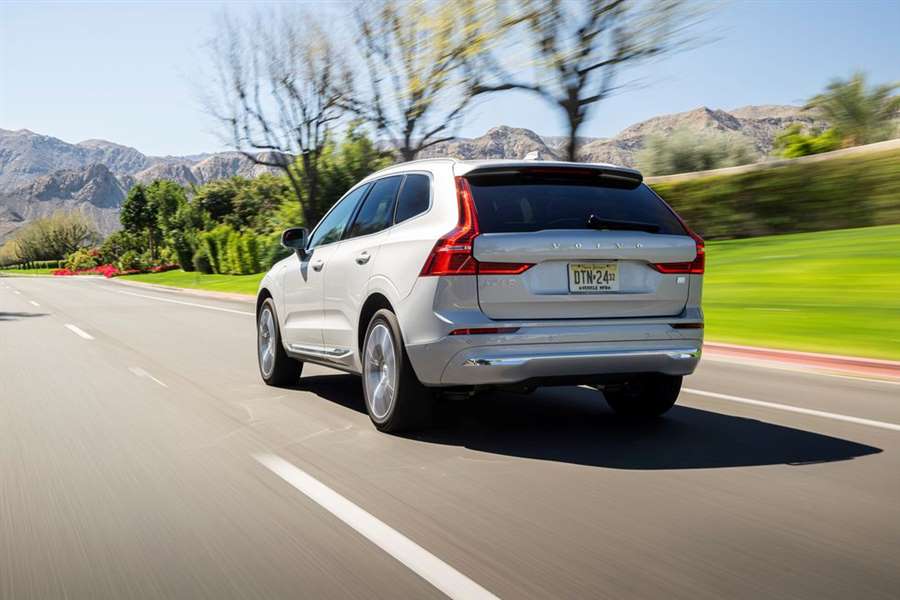
External updates are subtle for this refreshed and still quite handsome model, with a new grille and rear bumper its most noticeable external changes. Prices start at $55,845, so the XC60 Recharge T8 Extended Range is not cheap, though, in an era of rising car prices, surely reasonable. Nor is it as expensive as it feels, with quality fittings and distinctly good looks that amount to extraordinary style in an era where cheap plastics dominate and, with few exceptions, SUVs tend to toggle between ugly and boring. This XC60 Recharge is neither, and its revised, ultra-modern dash and uniquely stylish interior design help make it legitimate competition for models costing far more. Particularly appealing was our sample's fabric seating, a wool blend (available only in gray) that promises to be comfortable in extreme weather both hot and cold.
All in all, the XC60 Recharge T8 Extended Range provides proof that in car manufacture as in life, having the money to up one's game is preferable to not.
Source: https://www.caranddriver.com/reviews/a39475986/2022-volvo-xc60-t8-recharge-drive/
Tested: 2022 Polestar 2 Single Motor Is Cheaper but Slower
What's a Polestar? That was the follow-up question from a curious couple who asked us to identify the 2022 Polestar 2 we were driving in and around Santa Fe, New Mexico. To paraphrase, we explained that Polestar is an all-electric subsidiary of Volvo, and the squat Scandinavian-designed vehicle in question is currently the sole mass-produced model in its portfolio. Only the Volvo reference appeared to register, so we skipped the stuff about the Polestar 2 being the company's first EV, being built in China, and being sold directly to customers via the internet.
For 2022, new configuration choices and other notable improvements make the Polestar 2 more competitive in the premium-EV space, particularly versus the popular Tesla Model 3. Previously, the Polestar 2 was offered only as a feature-laden Launch Edition with dual motors and a $61,200 starting price. Now that many previously standard features are instead divided between the new $4000 Plus and $3200 Pilot packages, the starting point of the dual-motor powertrain configuration is $10,000 less. Making the '22 Polestar 2 even more accessible is the new single-motor, front-wheel-drive variant that went on sale in January. It starts at $47,200 (an amount that drops below $40K when you consider the available $7500 federal tax credit).
Since we've already tested a dual-motor 2 with the $5000 Performance package and Polestar says the 2022 alterations don't affect its driving behavior, we focused on the single-motor example. Its driving experience is less satisfying from an enthusiast perspective, but the differences are likely inconsequential to most shoppers. The single motor delivers 231 horsepower and 243 pound-feet of torque to the front wheels, producing the immediate thrust characteristic of electric vehicles. The sensation is available on demand from a dead stop or when passing on the interstate. The effect is simply amplified when two motors make a combined 408 ponies and 487 pound-feet, sending our dual-motor tester to 60 mph in 4.1 seconds. The single-motor model weighs 254 pounds less and is notably slower, taking 6.8 ticks to reach 60 mph. That 2.7-second delta is almost identical to the difference between the two powertrains at the drag strip, where the standard car completed the quarter-mile in 15.3 seconds at 93 mph versus the dual-motor's 12.7 seconds at 109 mph. The front-drive model's top speed is electronically limited to 101 mph; the extra electric motor feeding the rear axle ups that threshold to 125 mph.
The front-drive Polestar 2 also lacks the point-and-shoot dynamics that make its all-wheel-drive counterpart feel more playful. With the stability-control system set to ESC Sport, you can coax the AWD model's tail to step out in a controlled manner for maximum fun. For those less interested in such juvenile antics, the FWD version still feels athletic and refined. Even on the standard 19-inch wheels, it's remarkably planted and sure-footed, thanks in part to its standard summer tires—Michelin Primacy 4s, in the case of our test car. Skidpad grip amounts to 0.88 g, and stops from 70 mph happen in 161 feet, results that trail the dual-motor version's by a mere 0.02 g and four feet, respectively. The worst road imperfections are more pronounced on models with the optional 20-inch wheel-and-tire combo, but the cabin is impressively isolated from the outside world. The accurate steering includes three adjustable levels of effort—light, standard, and firm—but none generate any actual feedback. The most aggressive regenerative-braking setting provides 0.3 g of deceleration and enables true one-pedal driving. The brake pedal's firm action and short travel also feel more assuring than that of many other EVs.
Regardless of motor count, every Polestar 2 features a 75.0-kWh battery pack. While that net capacity is unchanged for 2022, Polestar credits increased range to "controller software and vehicle efficiency improvements." The EPA estimates that the single-motor model has a driving range of 270 miles per charge, which is only 21 miles more than the dual-motor's 249-mile rating (16 more than before). Plus, thanks to the magic of over-the-air updates, 2021 models can unlock that extra range too. The same applies to the car's maximum DC fast-charging speed, which rises from 150 to 155 kW (we saw a 154-kW peak at an Electrify America unit). Polestar says charging the battery from 10 to 80 percent at a 150-kW unit should take 33 minutes. In our 10 to 90 percent charge test, getting to 80 percent took slightly longer than claimed, at 39 minutes. And the charging rate drops off substantially above 80 percent; getting to 90 percent took 56 minutes, for an average rate of 75 kW, which is at the slow end of today's EVs.
The single-motor example we drove in New Mexico began the day with close to a full charge, and after two trips cruising back roads and highways between Santa Fe and Los Alamos (approximately 180 miles total), our battery's charge stood at about one-third. Back home on our 75-mph-range route, our front-drive test car traveled 220 miles on a full charge and averaged 89 MPGe. For comparison, the dual-motor Polestar 2 went 200 miles and averaged 84 MPGe in the same test.
Racking up those miles in the Polestar 2 is enjoyable thanks to an elevated seating position and a tall greenhouse with good forward visibility. The back seat is comfortable enough for two adults, and there's lots of cargo space between the rear hatch and a smaller underhood compartment. The 2's interior looks minimalistic, but the space has distinctive finishes and sturdy panel fitment. It feels like sitting in a Scandinavian coffeehouse–except there's only one easily accessible cupholder between the front seats; a second is hidden under the center-console lid. The centerpiece of the cockpit is the vertically mounted 11.2-inch touchscreen, which features an innovative Google-developed OS infotainment system meant to replicate the feel of a smartphone or a tablet.
While that's familiar to most folks, the Polestar brand and this high-riding hatchback aren't so much. Polestar acknowledges its lack of brand awareness and says increasing it was a top priority this year. After what can be considered a soft launch of the Polestar 2 more than a year ago, the company says it ramped up marketing in 2021. Likewise, it has been expanding its North American network of Polestar Spaces (a.k.a. dealer showrooms) from three in 2020 to around 30 today. The effort isn't expected to make Polestar the next Tesla, but it should improve sales and drum up interest for future models such as the forthcoming Polestar 3 SUV. Then maybe Polestar 2 early adopters won't have to answer so many questions.
Source: https://www.caranddriver.com/reviews/a37522506/2022-polestar-2-drive/
BMW iX review (2021)
So good you won’t care what it looks like
PROS
- State of the art purpose-built electric car from BMW
- Impressive to drive with outstanding comfort and refinement
- Eye-catching interior, packed with user-friendly technology
CONS
- Exterior design takes some getting used to
- Not all of the driver assistance tech works flawlessly
- Cheaper, more conventional BMW electric cars on the way
The BMW iX is a new purpose-built luxury electric car, and the flagship for BMW’s latest electric vehicle technology. It combines controversial exterior looks with a plush, ‘lounge-style’ interior and a seriously impressive driving experience – as well as offering a large number of modern safety and driving aids.
Rivals include the Audi E-Tron, Mercedes-Benz EQC and Tesla Model X.
Is the BMW iX any good?
If you’re in the market for a premium electric car and like to make a striking impression, BMW has definitely got you covered. Although you will also need to spend quite a lot of money. Two versions are available to buy now – iX xDrive40 and iX xDrive 50 – with an M-performance model badged xDrive M60 to follow in summer 2022.
At this stage, we’ve only driven the xDrive50 model, which commands an eye-watering £93,905 asking price in more basic Sport specification, rising to £96,905 for the fancier M Sport variant.
For that you get BMW Gen5 – fifth generation – electric motor and battery technology, and an ‘intelligent material mix’ structure that incorporates carbonfibre, aluminium and high-strength steel. For the xDrive 50, this results in the fairly spectacular combination of 523hp and 765Nm with a claimed WLTP driving range of 380 miles per charge.
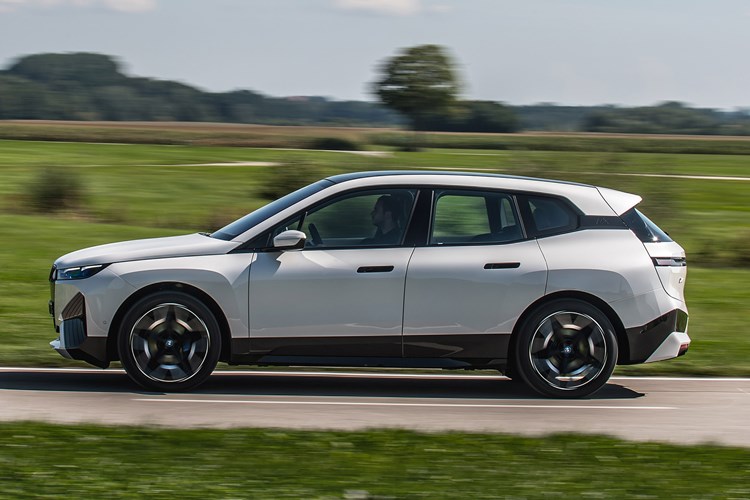
Living up to this promise, the iX is fast, comfortable, refined and outstandingly nimble for something that weighs over 2.5 tonnes and is similarly proportioned to a BMW X5 SUV. It also seems well able to deliver the on-paper driving range – though this will depend considerably on how much use you make of the available performance.
Other attention-grabbing features include a new generation of iDrive infotainment system (BMW Operating System 8) and a set of driver assistance features that include augmented-reality navigation, customisable digital and head-up displays, and adaptive brake recuperation that works superbly.
What about the way it looks?
BMW has never been a brand for building particularly beautiful cars, but there are some truly unusual angles and surfaces here. However, we would argue that it looks better in real life than it does in the pictures.
What’s more, not only is it unlikely to be mistaken for anything else – probably important for the kind of buyer who’s happy to drop nearly £100k on a BMW electric car – the design has been massaged to provide excellent aerodynamics.
This helps the iX drive faster and further, by allowing it to cut through the air more cleanly.
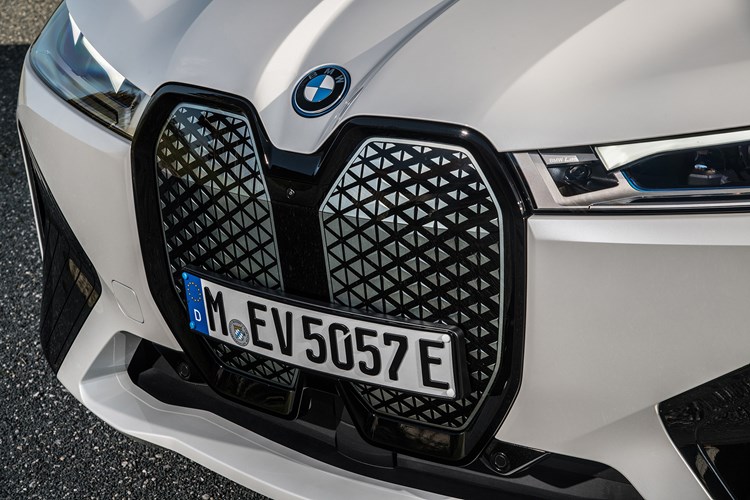
What’s it like inside?
The interior of the iX is just as unusual as the exterior – though not in such a controversial way. Here you’ll find the modern beauty of a contemporary luxury hotel room, rather than the edgy confrontation of modern art.
That’s not to say it will appeal to everyone. The slice of curving screen across the dashboard – actually two screens combined – is much as we’re coming to expect from EV interior design, while the latest iDrive software gives you comprehensive control in a reasonably instinctive manner. But the big, quilted seats are dramatic, the abrupt transition between surfaces and materials even more so, and the use of faceted crystal for some of the controls bordering on the gauche. The hexagonal steering wheel isn’t as odd to use as you might think, though.
Once again, this all helps the iX stand out against its rivals. It’s also very roomy inside, with lots of head and leg room front and rear. While there is a large battery pack under your feet, the floor doesn’t feel unnecessarily high.
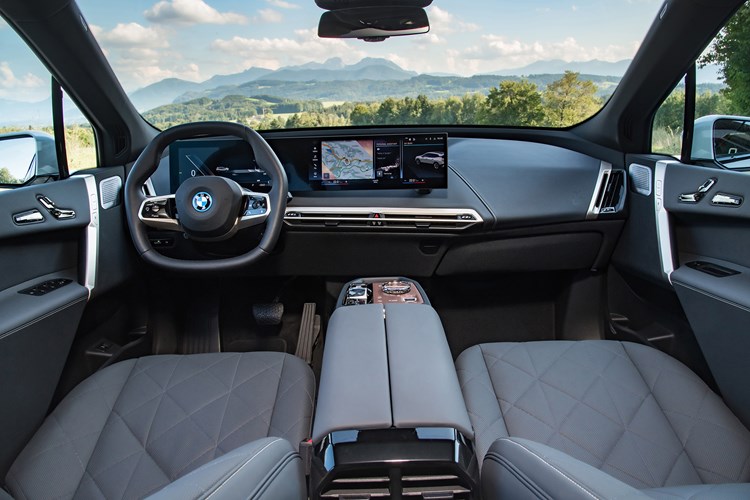
What’s it like to drive?
BMW has a reputation to uphold for exceptional driving dynamics as we move further and further into the age of electric cars, and the iX certainly isn’t going to do that reputation any damage.
Built around BMW’s first bespoke electric vehicle platform since the i3 city car, it has a very stiff bodyshell, which is then further reinforced by the large battery pack bolted to the underside. Being so stiff is a real benefit to every area of the car, as it allows the suspension to work more effectively.
The battery pack is heavy. In the xDrive50 model it contains an enormous 111.5kWh of electricity storage and weighs around 650kg. Because this weight is concentrated so low in the chassis, it not only gives the iX lots of extra strength, it also lowers the centre of gravity – which is further good news for stability when driving round corners.
Adding another touch of luxury class, the iX uses variable air suspension rather than steel springs.
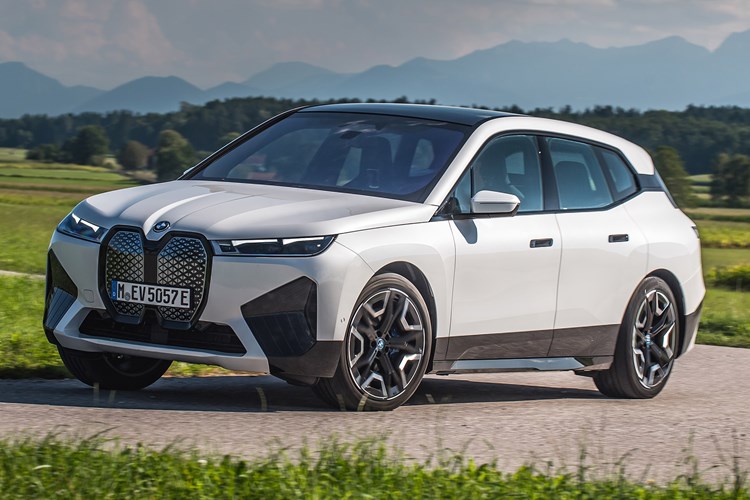
Combine all of the above, and you get a large car that manages to pull off the magic trick of riding bumpy surfaces brilliantly – despite 21-inch alloy wheels as standard – while also cornering with agility and precision on the twistiest of mountain roads. It leans a bit when really pressing on, but this only seems to highlight the depths of talent to the chassis tuning, allowing you to enjoy the process of handling it more.
Grip, meanwhile, isn’t an issue. The iX has two electric motors – one on each axle, making this the first BMW with electric all-wheel drive – and new control components mean that power can be measured out between them with exceptional speed. If one end of the car loses traction, the other compensates so swiftly the process is practically imperceptible.
Outright performance is mighty. The benchmark 0-62mph takes 4.6 seconds, but more significantly, BMW has engineered the electric motors to maintain their maximum power and torque at higher rpm. Overtaking punch is really impressive and the xDrive will hit and maintain its electronically limited 124mph top speed with ease (on derestricted autobahns in Germany).
What many owners will perhaps appreciate more, however, is the refinement. This is a very quiet car inside, even when travelling very quickly. BMW has taken the trouble to commission Oscar-winning movie composer Hans Zimmer to provide an electronic soundtrack that syncs beautifully with the way the car is being driven – but with this switched off, something that’s easily done via the infotainment system, the iX just whispers its way through the air.
What driver aids are available?
The iX is available with more driver assistance systems than BMW has ever offered before. Many of these will be familiar from other modern vehicles, but of particular interest are the elements that best show off the way the iX is properly aware of its surroundings.
For instance, it will monitor traffic lights to prompt you when they turn green. The head-up display will warn you if there are ‘dangerous’ bends ahead. The sat-nav can overlay direction information on a camera feed from the front of the car.
Our favourite example, however, is the ‘adaptive’ brake recuperation. This uses navigation and sensor data to vary the amount of braking effect you get from the motors whenever you release the accelerator – which sounds unnerving and complicated yet works remarkably intuitively. It will even allow the iX to coast at high speeds if that’s most efficient.
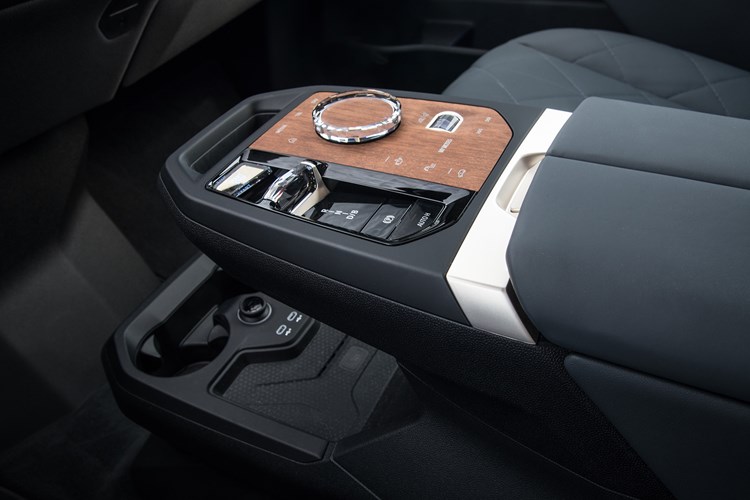
Engage the full B-mode, and you can drive almost exclusively without touching the brake pedal, as the motors will do the braking for you in all but extreme circumstances. And in exemplary fashion.
Better still, because of another integrated control unit balancing the effort between motor and traditional friction braking, when you do use the brake pedal, the feel and performance remains consistent at all times. Something that few other electric vehicles manage to pull off.
How long does it take to charge?
With 195kW fast-charging capability, the xDrive50 can be topped up with 93 miles of additional range in 10 minutes – or go from 10% to 80% in 35 minutes.
But this relies on very fast and comparatively expensive DC public chargers – the vast capacity of the battery pack means that you’ll need to allow 16 hours for 100% on a single-phase 7kW AC wallbox of the type most commonly found at UK homes and offices.
What different models and trims are available?
The iX is currently available in two versions: the xDrive40 priced from £69,905 and the xDrive50 priced from £93,905.
We’ve covered the stats of the xDrive50 in detail above. The xDrive40 produces 326hp and 630Nm of torque, does 0-62mph in 6.1sec, and has the same 124mph top speed; WLTP driving range is 257 miles.
Both versions are available in Sport and M Sport trim levels.
Standard equipment highlights for the iX Sport include an 18-speaker harmon/kardon hi-fi system, 21-inch alloy wheels, heated front seats, four-zone climate control and a substantial number of driver assistance systems.
The upgrade to iX M Sport – which costs an extra £3,000 – adds a styling package, bigger brakes, dark headlight glass and anthracite roof lining.
A car like this never has a short options list, and among the add-ons for the standard models are massaging front seats, heated steering wheel and other cabin surfaces, Bowers and Wilkins hi-fi upgrade, ‘Skylounge’ panoramic roof, Laserlight headlights, and an interior camera that can be used for security and fun.
High-performance BMW iX M60 on sale in summer 2022
In summer 2022 an M-performance model called the iX xDrive M60 joins the range. Power output for this is now confirmed at a staggering 619hp combined with a huge 1,100Nm peak torque, delivering 0-62mph in 3.8 seconds and an electronically limited 155mph top speed.
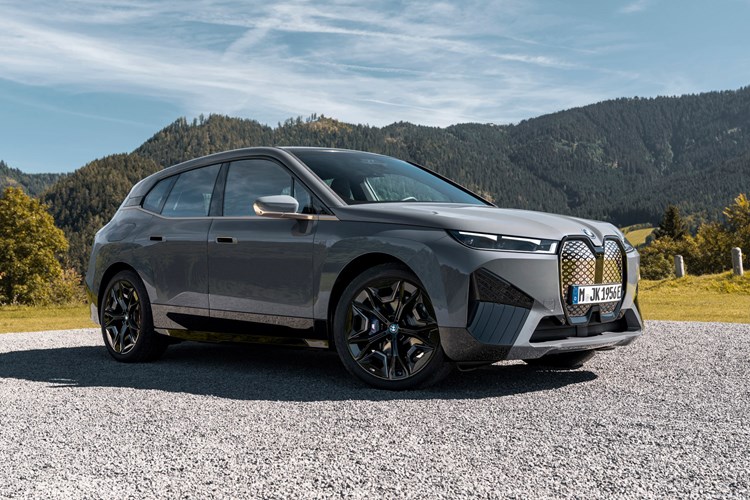
Maximum claimed WLTP driving range is equally impressive at 357 miles per charge, though it needs to impress, given pricing starts at £111,905.
For the money you also get bespoke BMW M suspension tuning, 22-inch alloy wheels, soft-close doors, powerful BMW Laserlights instead of regular LED headlights, and a technology suite that includes an interior camera, Bowers & Wilkins hi-fi, massaging front seats, heated everything, and BMW Parking Assistant Professional.
What else should I know?
The built-in connectivity means BMW will offer new features and allow customers to pay for upgrades to their iX via over-the-air updates. Among the things coming this way are an automated parking system that allows the car to learn and self-drive certain short-distance manoeuvres, which you’ll then be able to control from outside the car using your phone.
A heated element in the front grille area ensures all of the cameras and sensors built into the nose will still work when it’s snowing. BMW has put a lot of thought into this car.
BMW iX verdict
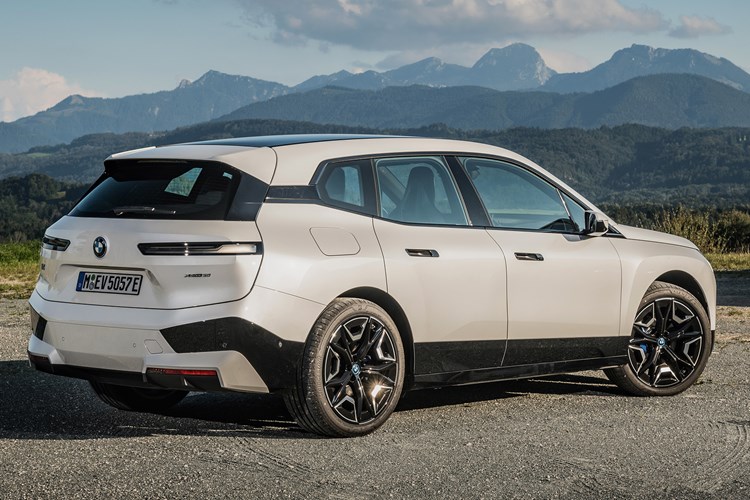
If you want a stand-out, high-price, high-quality electric car, close to the cutting edge of the current state of battery electric vehicle technology then the BMW iX could well be for you. The look of the thing is sure to raise more than a few eyebrows, but as a statement-maker that may be exactly what you’re looking for anyway.
Regardless, the interior is inviting, and the impressive blend of performance and serenity achieved by the driving experience means that even the most doubtful potential customer should at least take an iX for a test drive.
What we like
We can think of few other cars that are capable of providing such comprehensive ride comfort in combination with such cornering athleticism. The iX is at once a limousine and a creditable substitute for a sportscar – all while producing zero emissions in motion, thanks to its electric drive system.
That electric drive not only gives awesome performance, but also does things an ordinary combustion car can’t – most notably the adaptive recuperation that practically makes the brake pedal a thing of the past. Traction is mega as well, thanks to the twin-motor setup.
The technology used throughout – from the materials it’s built from to the latest iDrive – matches the iX’s price tag, while the refinement and the luxury interior put some proper icing on what is a pretty fancy automotive cake.
What we don’t like
Looks are subjective, so we’ll pass over that.
More of a concern is that not all of the driver assistance systems work consistently. With everything switched on, the iX can theoretically accelerate up to speed limits automatically as well as slow down for hazards and ‘assist’ through turns (though this relies on you touching the steering wheel – it is not a fully autonomous car). However, we found many of these facilities unreliable in action, and certainly would caution against relying on them too heavily.
Beyond this, most of the issues with the iX are the same you’ll face with any electric car – the classic being the way charging it up takes longer than filling a fuel tank. But as we all know there are means of coping with these things, and it’s getting easier and easier to live with an EV all the time.
(https://www.parkers.co.uk/bmw/ix/review/)
2022 Nissan Pathfinder FWD SUV First Test: Lighter, But Is It Better?
It uses the same platform and engine as its predecessor, but the new Pathfinder looks like the brawny SUVs of old.
We already put the 2022 Nissan Pathfinder three-row SUV with all-wheel-drive through its instrumented paces. Now it's time to get the front-wheel-drive version of Nissan's latest Pathfinder in the hands of MotorTrend's test team so consumers know what to expect from the rest of the lineup.
The Pathfinder has had an interesting history and is unique in its path to reinvention, having flipped from body-on-frame to unibody repeatedly during its lifecycle. It started as a two-door SUV in 1986 on Nissan's compact truck body-on-frame platform and added a four-door in 1989, discontinuing the two-door a year later in North America. The second-gen Pathfinder went on sale in 1995 with unibody construction. Then the third-generation SUV made a surprising return to body-on-frame in 2004 for the '05 model year, only to pivot back to unibody for the fourth-generation Pathfinder in 2012, sharing a platform with the Nissan Altima, Maxima, and Murano, among others.
For this fifth generation, the Pathfinder actually stays unibody on the same platform, but it drops the milquetoast design in a return to the squared-off, brawny looks we've come to associate with this SUV, regardless of its underpinnings. The styling changes inside and out are in keeping with a resurgence in design among new Nissan offerings of late.

2022 Nissan Pathfinder Competitively Priced
The two-wheel-drive Pathfinder starts at $47,340, and at $49,865, our test model didn't ring in much higher. That price reflects the addition of $730 running boards, a $745 two-tone premium paint scheme, a $795 lighting package with illuminated kick plates and welcome lighting, and $255 carpeted floormats. A comparable 2021 Toyota Highlander Platinum trim FWD starts slightly higher at $48,755, and a 2022 Honda Pilot Elite costs about $2,000 more but only comes in AWD.
Nissan also carried over the previous Pathfinder's 3.5-liter V-6 engine, which generates 284 horsepower and 259 lb-ft of torque, but the previous model's CVT has been replaced with a new nine-speed automatic transmission with a meaty shifter. It can tow 6,000 pounds and comes with a tow hitch and harness as standard equipment.
Although the pleasant-sounding V-6 feels more powerful and the new transmission snappier at propelling the lighter FWD model, the test numbers don't bear out our seat-of-the-pants observations. The front-drive Pathfinder required 7.1 seconds to go from 0 to 60 mph and 15.5 seconds to do the quarter mile. The Pathfinder with AWD was a shade quicker at 7.0 seconds to 60 mph, making it a strong performer in the segment. The 2022 Jeep Grand Cherokee L Limited powered by a 3.6-liter V-6 (293 hp/260 lb-ft) and AWD needed 7.3 seconds and 15.5 seconds, respectively.
Road test editor Erick Ayapana found the Pathfinder FWD "super-tricky to launch" because the engine easily overwhelms the tires. "With traction on, it'll cut power to reduce wheelspin. With traction off, any hint of wheelspin results in a 1-2 upshift. Manual mode isn't much of a manual mode because it'll upshift to second automatically. So getting the launch right is pretty much a guessing game."

Behind The Wheel
Ironically, the lighter, front-drive Pathfinder felt heavier to drive at times on our winding test track, and the stability control can often be too aggressive. However, tire squeal and head toss were kept to a minimum, even during hard cornering. The suspension provides a smooth ride over rough surfaces, and there is little body motion over bumps.
Out on the figure-eight course, the Pathfinder completed the loop in 28.4 seconds at an average of 0.59 g, performing better than road test editor Chris Walton expected, though he did find its steering to be unnecessarily heavy during his looping. "The chassis is quite good, but you can't go to the power early because the front-wheel-drive system doesn't have any sort of limited slip other than traction control, which kills the exit," Walton noted. The all-wheel-drive Pathfinder rounded the course a full second quicker at 27.4 seconds, and the Grand Cherokee L (also with AWD) essentially split the difference at 27.9 seconds. When it comes to stopping power, the FWD Pathfinder needed 130 feet to haul itself down from 60 mph to 0. That's slightly longer than the Grand Cherokee L at 127 feet but a ways off of the AWD Pathfinder's impressive 114 feet, which is difficult to explain with both Pathfinders using the same tires. Ayapana found the Pathfinder's brakes to have "adequate bite and good body control." Walton said the medium-firm brake pedal offers "good feel and easy modulation."
As far as fuel efficiency goes, the 2022 Pathfinder adds stop-start, which helps improve its EPA numbers slightly to 21/27/23 mpg city/highway/combined. The heavier Grand Cherokee L is predictably thirstier at 19/26/21 with RWD.
Nissan's ProPilot Assist (adaptive cruise, steering assist, traffic sign recognition) provides excellent lane-centering steering assist. Once adaptive cruise is engaged, simply press the ProPilot button for full capability. Rest your fingers lightly on the steering wheel and feel it make minor adjustments as you're speeding down the highway. With Navi-Link, the vehicle slows for freeway curves and exit ramps, and the system alerts the driver to changes in the speed limit. It's without question one of the best driver assist systems on the market.

More Upscale Interior
The 2022 Pathfinder's cabin feels premium for a vehicle that costs less than $50,000 and comes with a dose of industrial toughness: Everything is big and square and blocky. Our test model had great-looking saddle-brown seats and accents on the door and dashtop, which contrast well with the black interior; white and gold stitching help complete the upscale look. The Platinum trim comes with a 12.3-inch digital gauge cluster, a head-up display, an 8.0-inch touchscreen infotainment system, a motion-activated power tailgate, and 20-inch alloy wheels.
Open the wider-opening rear doors and climb into the heated second-row captain's chairs fitted to this model (making it a seven-passenger family vehicle instead of eight), and you'll find them comfortable with ample thigh support. To get to the third row, there are buttons on the base of the second-row seat and the seat back. Press one, and the seat tilts and then flies forward—even with an empty car seat installed. It's easy enough for kids to use, but make sure they stand back while it performs its spring-loaded gymnastics. It creates a large opening for easy access to the third row, which now seats three. Space is decent in the third row, and the passengers have access to air vents and USB charging ports.
The third-row seats also fold completely flat, and the cargo area is augmented by a deep well under the floor. The rear cargo space also comes with tie-downs, bag hooks, and a 12-volt socket.
The Pathfinder faces a lot of competition, with stalwarts such as the Highlander, Pilot, and Ford Explorer, not to mention relative newcomers, including the Hyundai Palisade, the 2020 MotorTrend SUV of the Year Kia Telluride, and the newest entrant, the Jeep Grand Cherokee L. Nissan has reinvented the Pathfinder many times over the years in order to assert leadership in the segment. This time around Nissan kept the Pathfinder's carlike platform but returned it to a truckier look in an attempt to remix the best of its past efforts. The result, as summarized by Walton: "Not bad for a grocery getter and better than it probably needed to be."
| 2022 Nissan Pathfinder Platinum Specifications | |
| BASE PRICE | $47,340 |
| PRICE AS TESTED | $49,865 |
| VEHICLE LAYOUT | Front-engine, FWD, 7-pass, 4-door SUV |
| ENGINE | 3.5L direct-injected DOHC 24-valve 60-degree V-6 |
| POWER (SAE NET) | 284 hp @ 6,400 rpm |
| TORQUE (SAE NET) | 259 lb-ft @ 4,800 rpm |
| TRANSMISSION | 9-speed automatic |
| CURB WEIGHT (F/R DIST) | 4,536 lb (55/45%) |
| WHEELBASE | 114.2 in |
| LENGTH x WIDTH x HEIGHT | 197.7 x 77.9 x 69.7 in |
| 0-60 MPH | 7.1 sec |
| QUARTER MILE | 15.5 sec @ 92.3 mph |
| BRAKING, 60-0 MPH | 130 ft |
| LATERAL ACCELERATION | 0.76 g (avg) |
| MT FIGURE EIGHT | 28.4 sec @ 0.59 g (avg) |
| EPA CITY/HWY/COMB FUEL ECON | 21/27/23 mpg |
| ON SALE | Now |
(https://www.motortrend.com/reviews/2022-nissan-pathfinder-fwd-first-test)

